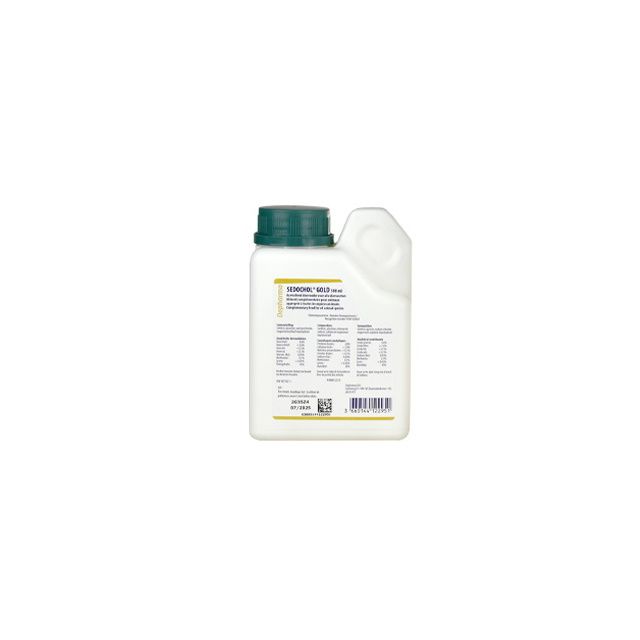The liver of the cat
All the blood from the cat's gastrointestinal tract, spleen, and pancreas passes through the liver. This blood contains digested food, waste products, and foreign substances such as medications. The liver aids in digestion and purifies the blood. Additionally, the liver produces many proteins, including those responsible for blood clotting. If a cat suffers from liver problems, these functions can be disrupted. Cats that don't eat can develop fatty liver disease within just a few days.
Pharmacy4pets offers various dietary supplements that can support liver function.
Symptoms of Liver Problems in Cats
Cats with liver problems often display vague symptoms that can also fit other diseases. A very specific sign that something is wrong with the liver or bile ducts is jaundice: a yellowing of the mucous membranes, whites of the eyes, and skin.
Symptoms of liver diseases in cats include:
- Poor appetite.
- Weight loss.
- Lethargy.
- Vomiting.
- Jaundice.
- Fever.
- Diarrhea.
- Excessive drinking and urination.
- In kittens: insufficient growth.
- Fluid in the abdominal cavity (ascites).
- Increased tendency to bleed.
- Abnormal behavior: extreme sluggishness, sleepiness, seeming blindness, walking in circles, trying to walk through walls, epileptic seizures.
Liver Problems in Cats
Various liver diseases occur in cats. We have listed the most common conditions for you.
Fatty Liver in Cats
The most common liver disease in cats is fatty liver. Fatty liver can develop if a cat, for whatever reason, eats poorly. Cats that don't eat can develop fatty liver within just a few days. The cat's body needs to burn stored body fat to get energy. This is the liver's task, but it requires substances from the cat's diet. If the cat does not eat, these nutrients are not available, and the fat to be burned accumulates in the liver. This causes the liver to function less efficiently, making the cat even more nauseous and even less inclined to eat.
The treatment of fatty liver disease involves identifying and treating the cause of the poor appetite and getting the cat to eat again. Usually, medication against nausea and/or appetite stimulants are used. Additionally, it's important for the cat to start eating as soon as possible. Often, it's necessary to place a feeding tube or to force-feed the cat. If the cat starts eating again, the prognosis for fatty liver disease is good, depending on the underlying cause.
Biliary Tract Inflammation in Cats
In cats, there are two types of biliary tract inflammations, known as cholangitis. The inflammation can be caused by bacteria, also known as neutrophilic cholangitis. These bacteria enter the bile from the intestines. Bacterial biliary tract inflammation is treated with antibiotics.
There can also be a biliary tract inflammation without bacteria; a sterile biliary tract inflammation or lymphocytic cholangiohepatitis. In this condition, the bile ducts are inflamed and dilated. Cats with this inflammation often need to be treated for life with anti-inflammatory drugs. Sterile biliary tract inflammation often occurs together with pancreatitis and intestinal inflammation (IBD) and is then called 'triaditis' (three inflammations).
Liver Shunt in Cats
In a liver shunt, a blood vessel is incorrectly formed, causing the blood to bypass the liver instead of flowing through it. As a result, certain toxic substances, such as ammonia, are not processed in the liver but remain in the blood, causing severe neurological symptoms. Kittens with a liver shunt usually grow very poorly. Bladder stones can also develop due to a liver shunt.
A liver shunt can often be corrected surgically. In some cases, a special low-protein liver diet combined with a specific laxative is sufficient to control the symptoms.
Liver Tumors in Cats
The most common liver tumor in cats is malignant lymphoma. This tumor often responds well to chemotherapy. Other primary liver tumors, i.e., tumors originating in the liver, can sometimes be surgically removed. Metastases from other tumors can also occur in the liver. The prognosis in such cases is often poor.
Other Liver Conditions in Cats
Dry FIP, Feline Infectious Peritonitis, a nasty viral disease, can also occur in the liver. Cats with PKD, Polycystic Kidney Disease, can have cysts in the kidneys as well as in the liver. The liver is a reactive organ, and liver values in the blood often rise with other conditions, such as gastrointestinal problems or an overactive thyroid. So, in fact, there may be nothing wrong with the liver, but blood tests indicate otherwise.
Diagnosing Liver Problems in Cats
That a liver disorder is present is sometimes already evident from the general examination: if the cat suffers from jaundice, it is clear that there is a problem with the liver and/or bile ducts. In other cases, blood tests usually reveal that there is something wrong with the liver. To determine the exact cause, further investigation is necessary. Usually, an ultrasound is performed, sometimes with biopsies or a puncture of the bile. Additional blood tests (for example, the level of red blood cells or investigation into blood clotting) can help diagnose the condition.
Treating Liver Problems
Of course, the treatment depends on the nature of the liver problems. Much has already been discussed under the respective conditions.
Diet for Liver Problems
Additionally, the liver can be supported with special diet food and/or dietary supplements. Silybin is the main component of milk thistle (Silybum marianum). Silybin has been shown to support normal liver function.
Silybin can be found in Silycure and Zentonil Advanced. The latter also contains an important antioxidant (SAMe), which is often deficient in liver disease.
Since the liver is such an important organ, it is vital to recognize and appropriately treat liver problems in your cat. Pharmacy4pets helps support your cat's healthy liver function. If you have any questions about our products or about liver problems in your cat, please contact us.

